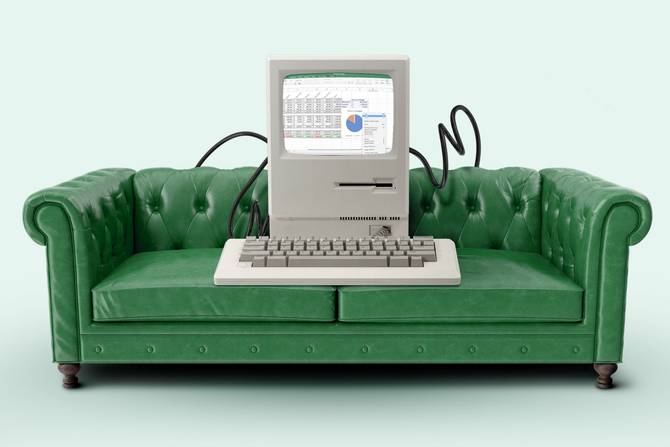Hey there. We’ve been hearing a lot about “Bare Minimum Mondays.” Now we invite you to be ahead of the next trend and embrace “Why Bother Wednesdays.” We bet you can push one thing off today’s to-do list into tomorrow! Of course, then it’s already “Throw It Away Thursday,” which is immediately followed by “Phone It In Friday.” 
In today’s edition:
 Predicting quitters Predicting quitters
 Coworking Coworking
—Sam Blum, Adam DeRose,
|
|
Gizela Glavas/Getty Images
To predict when an employee might quit their job, you don’t need to don the garb of an ancient soothsayer and stare intently into a crystal ball. You might, however, try consulting predictive attrition AI tools, which seemingly provide a window into the future. Analyze a variety of data points (from public salary info and turnover rates, to external factors like economic trends and industry shifts), then behold: You suddenly know which of your employees has a higher likelihood of quitting and you can intervene before it’s too late. But like all good algorithms, there could be a dark side.
Compiling troves of data in the service of predicting quitters is nothing new. IBM’s Watson supercomputer, released in 2010, can forecast attrition rates with 95% accuracy, CEO Ginni Rometty claimed in 2019. A glut of companies, such as Retrain AI and Eightfold AI, also harness big data to better forecast attrition, which has become more enticing to HR departments in certain industries amid layoffs and budgetary shortcomings: In a recent Capterra survey of 300 HR leaders, 98% said they’d use algorithms to help reduce labor costs during the next recession.
Predictive attrition software—which falls under the larger umbrella of people analytics—can be used to engage, motivate, and even promote workers, explained Andrew Spott, president and co-founder of HR Signal, a vendor of retention software. “We’re a people-centric company,” he told HR Brew. “Our job is to try and help employees and people grow better in their careers, and it’s typically easier to grow where you are than leav[e] an employer.” But the fear among advocates like Wilneida Negrón, director of policy research at the advocacy organization Coworker, is that the algorithms could be used for punitive measures, like laying off workers deemed a flight risk.
Read more here.—SB
|
|
TOGETHER WITH UBER FOR BUSINESS
|
|
BEEP BEEP! Whew, sounds like a traffic jam out there. Well, buckle up and sit back, because Uber for Business is here to help navigate your HR challenges with ease.
If you want to recruit, retain, and reward your global talent with rides and meals, you need to check out Uber for Business.
HR pros can customize flexible benefits and perks in one cost-effective platform. Provide a job candidate a ride to the office for an interview, share tasty treats for a team birthday, or send dinner to a team working late.
Use Uber for Business to provide an exclusive, versatile experience that elevates your business and appreciates your people.
Level up your benefits.
|
|
Shireen El-Maissi
On Wednesdays, we schedule our weekly 1:1 with HR Brew’s readers. Want to be featured in an upcoming edition? Click here to introduce yourself.
Shireen El-Maissi’s first draw to HR and recruiting was (checks notes)...horoscopes? El-Maissi said it was her interest in the personality traits and characteristics associated with different astrological signs that led her to the people profession. After going to school for psychology to amplify her understanding of human behavior, she realized she had a knack for recruiting and talent acquisition. El-Maissi estimates that she’s talked with more than 5,000 different people over her career so far. “Can you imagine how many personality types I’ve gotten?” she said.
After years in external and internal recruiting, she’s been leading Blueboard’s talent acquisition since last June. El-Maissi says candidates are still “shocked” by her recruiting process of “proactive communication and quick responsiveness” and hopes more HR pros will work to strengthen their recruiting process and better incorporate it into the employee lifecycle.
What’s the biggest misconception people might have about your job?
That the employee experience begins on their first day or during onboarding. The employee experience starts in the interview process for potential employees. The interview process is a great chance to give an employee an idea of what it might be to look at the company. Onboarding is the second step of it all. So, ultimately, attention should be given to the talent acquisition process. This includes transparency, responsiveness, representation in the hiring team, and clarity through questions.
What’s the most fulfilling aspect of your job?
Finding incredible talent that I know will get the job after my first phone call with them. Taking those candidates to the office stage makes me emotional every time. I want to help the company move forward. Each time I learn about goals, I know we need the best and most engaged talent to help reach those goals, so finding and fostering the right talent to do that makes me feel fulfilled.
Keep reading here.—AD
|
|
|
Greatness for all. The revolutionary minds at Nike had one goal: Create a more inclusive workplace by 2025. In this webinar, you’ll learn how 10KC helped Nike implement a career-boosting, connection-building mentorship program that expedited their DE&I goals—and how you, too, can foster inclusivity at your workplace. Watch it here.
|
|
Today’s top HR reads.
Stat: Attrition for DE&I roles was at 33% at the end of 2022 compared with 21% for non-DE&I roles. (NBC News)
Quote: “It’s about more than sleep. I want parents to be able to enjoy their parental leave and to know, once the time comes, the transition back to work will be smooth, free of anxiety and exhaustion, and most importantly, they will be safe to do so.”—Hannah Love, baby sleep consultant, on addressing post-parental leave sleep deprivation in the workplace (WorkLife)
Read: Is it possible we’ve reached the end of an era where employees have the upper hand? (Fast Company)
Learn: It’s never a bad time to get better at your job. Our Difficult Conversations at Work course is made for the HR professional looking to improve their communication skills during those tough discussions. Sign up now.
|
|
-
SCOTUS’s ruling on affirmative action in higher ed could have ripple effects for corporate DE&I.
-
Workers are moving in droves from the oil industry to the renewable tech space in search of job stability.
-
Hitachi plans to hire 30,000 US workers by 2025, according to its CEO.
-
New York City HR departments plan for the enforcement date of AI audit bill Local Law 144—which is now barely a month away.
|
|
Feel like you’re searching for a unicorn in space without a spacesuit? Join HR Brew tomorrow for a free virtual event where you may just find that spacesuit. Duolingo talent expert Jocelyn Lai will share tactics and techniques to help us remain agile in this dizzying landscape of recruiting.
Sign up for free right here.
|
|
Catch up on the top HR Brew stories from the recent past:
|
|
|








